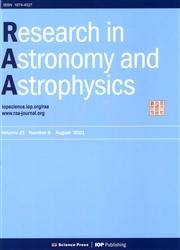富钙质超新星 PTF 10iuv 的能量来源和爆炸机制
IF 2.8
4区 物理与天体物理
Q3 ASTRONOMY & ASTROPHYSICS
引用次数: 0
摘要
PTF10iuv是一颗富钙(Ca-rich)超新星(SN),本文对其光曲线(LCs)进行了详细建模,以约束其抛射物的物理性质、能量来源以及爆炸机制。我们发现,56Ni模型和56Ni加周星体相互作用模型无法解释低熔点,而四元素(56Ni、48Cr、52Fe和44Ti)模型可以解释低熔点。该模型得出的PTF 10iuv的喷射质量(M⊙)与亚钱德拉塞卡质量白矮星合并时的质量一致。早期白矮星的能量主要来自于质量为∼0.03 M⊙的56Ni,而48Cr和52Fe的贡献可以忽略。得出的44Ti质量(∼0.25 M⊙)是富钙SN 2005E的44Ti质量上限的1.8倍。我们认为,减去未知的宿主星系的贡献,再加上其他长寿命元素(如57Co、55Fe、60Co)的通量,可以减少44Ti的数量,这个值可以被看作是一个上限。本文章由计算机程序翻译,如有差异,请以英文原文为准。
The Energy Sources and the Explosion Mechanism of Ca-rich Supernova PTF 10iuv
In this paper, we perform the detailed modeling for the light curves (LCs) of PTF 10iuv which is a calcium-rich (Ca-rich) supernova (SN) to constrain the physical properties of its ejecta and the energy sources, as well as the explosion mechanism. We find that the 56Ni model and the 56Ni plus circumstellar interaction model fail to explain the LCs, while the four-element (56Ni, 48Cr, 52Fe, and 44Ti) model can account for the LCs. The ejecta mass of PTF 10iuv derived by the model ( M⊙) is consistent with that of the merger of a sub-Chandrasekhar mass white dwarf. The early-time LCs were mainly powered by 56Ni whose mass is ∼0.03 M⊙, while the contributions of 48Cr and 52Fe can be neglected. The derived 44Ti mass (∼0.25 M⊙) is ∼1.8 times the upper limit of the derived 44Ti mass of Ca-rich SN 2005E. We suggest that subtracting the contributions of the host-galaxy, which are unknown, and including the flux from other long-lived elements (e.g., 57Co, 55Fe, 60Co) can reduce the amount of 44Ti, and that this value can be regarded as an upper limit.
求助全文
通过发布文献求助,成功后即可免费获取论文全文。
去求助
来源期刊

Research in Astronomy and Astrophysics
地学天文-天文与天体物理
CiteScore
3.20
自引率
16.70%
发文量
2599
审稿时长
6.0 months
期刊介绍:
Research in Astronomy and Astrophysics (RAA) is an international journal publishing original research papers and reviews across all branches of astronomy and astrophysics, with a particular interest in the following topics:
-large-scale structure of universe formation and evolution of galaxies-
high-energy and cataclysmic processes in astrophysics-
formation and evolution of stars-
astrogeodynamics-
solar magnetic activity and heliogeospace environments-
dynamics of celestial bodies in the solar system and artificial bodies-
space observation and exploration-
new astronomical techniques and methods
 求助内容:
求助内容: 应助结果提醒方式:
应助结果提醒方式:


